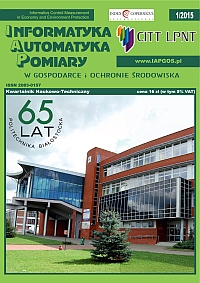Arshdeep Kaur A.K.: Comparison of Mamdani-Type and Sugeno-Type Fuzzy Inference Systems for Air Conditioning System International Journal of Soft Computing and Engineering, 2, 2012, 323-325.
Cheng Y.-T., Chung M.-T.: A New Measurement Method on Correlation Coefficient for Attribute Fuzzy Interval Data and Its Applications InternatIonal Journal of IntellIgent technologIes and applIed statistics, Vol. 7, 2014, no. 1, 27-36.
Christian R.A., Lad R.K., Deshpande A.W., Desai N.G.: Fuzzy MCDM approach for addressing composite index of water and air pollution potential of industries International Journal of Digital Content Technology and its Applications, 1, 2008, 4-71.
Cirstea M.N.: Neural and fuzzy logic control of drives and power systems Newnes, 2002.
Mamdani E.H., Assilian S.: An experiment in linguistic synthesis with a fuzzy logic controller International Journal of Man-Machine Studies, 7, 1975, 1-13.
Fodor J.C.: Contrapositive symmetry of fuzzy implications Fuzzy Sets and Systems, 1995.
Fodor J.C.: On fuzzy implication Fuzzy Sets and Systems, 42, 1991, 293-300.
Habdank-Wojewódzki S.: Zaawansowany regulator rozmyty w zastosowaniach do ruchu drogowego, winntbg.bg.agh.edu.pl/rozprawy/9931/full9931.pdf, Krakow, 2009.
Hao Ying, Yongsheng Ding, Shaokuan Li, Shihuang Shao: Comparison of Necessary Conditions for Typical Takagi–Sugeno and Mamdani Fuzzy Systems as Universal Approximators IEEE Transactions on Systems, Man, and Cybernetics, 29, 1999, 508-514.
Hao Ying, Yongsheng Ding, Shaokuan Li, Shihuang Shao: Typical Takagi-Sugeno and Mamdani fuzzy systems as universal approximators: necessary conditions and comparison IEEE Conference Publications, 1, 1998, 824-828.
Harald König L.L.: An Advanced Inference Strategy for Fuzzy Control Based on a New Fuzzy Implication Function Fuzzy Systems, 2,1996, 1296-1302.
Jantzen J.: Fundations of Fuzzy Control John Wiley & Sons Ltd., England, 2007.
Kacprowicz M., Niewiadomski A., Cader A., Yatsymirskyy M., Przybyszewski K. (Eds.): Managing Data on Air Pollution Using Fuzzy Controller Computer Methods in Practice, Exit Publishing House, Warsaw, Poland, 2012, 46-57.
Karnik N.N., Mendel J.M.: Centroid of a type-2 fuzzy set Information Sciences, 132, 2001, 195-220.
Kuropka J.: Badania redukcji tlenków azotu amoniakiem na katalizatorach ziarnistych, Ochrona Środowiska, 2(53), 1994, 15-18.
Leski J.: Systemy Neuronowo-Rozmyte, Scientific and Technical Publishing, Warsaw, 2008.
Liang Q, Mendel J.M.: Interval Type-2 Fuzzy Logic Systems: Theory and Design IEEE Transactions on Fuzzy Systems, 8, 2000, 535-550.
Wang L.-X., Mendel J.M.: Generating Fuzzy Rules by Learning from Examples IEEE Transactions on Fuzzy Systems, 22, 1992, 1414-1427.
Majumder D., Dwijesh K.: Fuzzy logic and its application in technology and management Narosa, 2007.
Mendel J.M.: Uncertain Rule-Based Fuzzy Logic Systems: Introduction and New Directions Prentice Hall, 2001.
Niewiadomski A.: Methods for the Linguistic Summarization of Data: Applications of Fuzzy Sets and Their Extensions Academic Publishing House, Warsaw, 2008.
Rutkowska D.: Neuro-Fuzzy Architectures and Hybrid Learning Physica-Verlag, A Springer-Verlag Company, Heidelberg, New York, 2002.
Rutkowska D., Pilinski M., Rutkowski L.: Sieci neuronowe, algorytmy genetyczne i systemy rozmyte, PWN, Warszawa-Łódz, 1997.
Rutkowski L.: Metody i techniki sztucznej inteligencji, PWN, Warszawa, 2009.
Starczewski J.T., Montseny E., Sobrevilla P. (Eds.): Extended Triangular Norms on Gaussian Fuzzy Sets. EUSFLAT Conf., Universidad Polytecnica de Catalunya, 2005, 872-877.
Starczewski J.T.: On Defuzzification of Interval Type-2 Fuzzy Sets Proceedings of the 9th International Conference on Artificial Intelligence and Soft Computing, Springer-Verlag, 2008, 333-340.
Starczewski J.T.: A Triangular Type-2 Fuzzy Logic System IEEE International Conference on Fuzzy Systems, IEEE International Conference on Fuzzy Systems, 2006, 1460-1467.
Tomsovic K.: Fuzzy Systems Applications to Power Systems 2000.
Wierzchon S.T.: Elementy teorii zbiorów rozmytych, www.ipipan.waw.pl/~stw/esi/sterowniki.pdf, 2009.
Wu H., Jerry M.: Mendel Uncertainty Bounds and Their Use in the Design of Interval Type-2 Fuzzy Logic Systems IEEE Transactions on Fuzzy Systems, 2002, 10, 622-639.
Zadeh L.A.: The concept of a linguistic variable and its application to approximate reasoning Inform, 8, 1975, 199-249.







